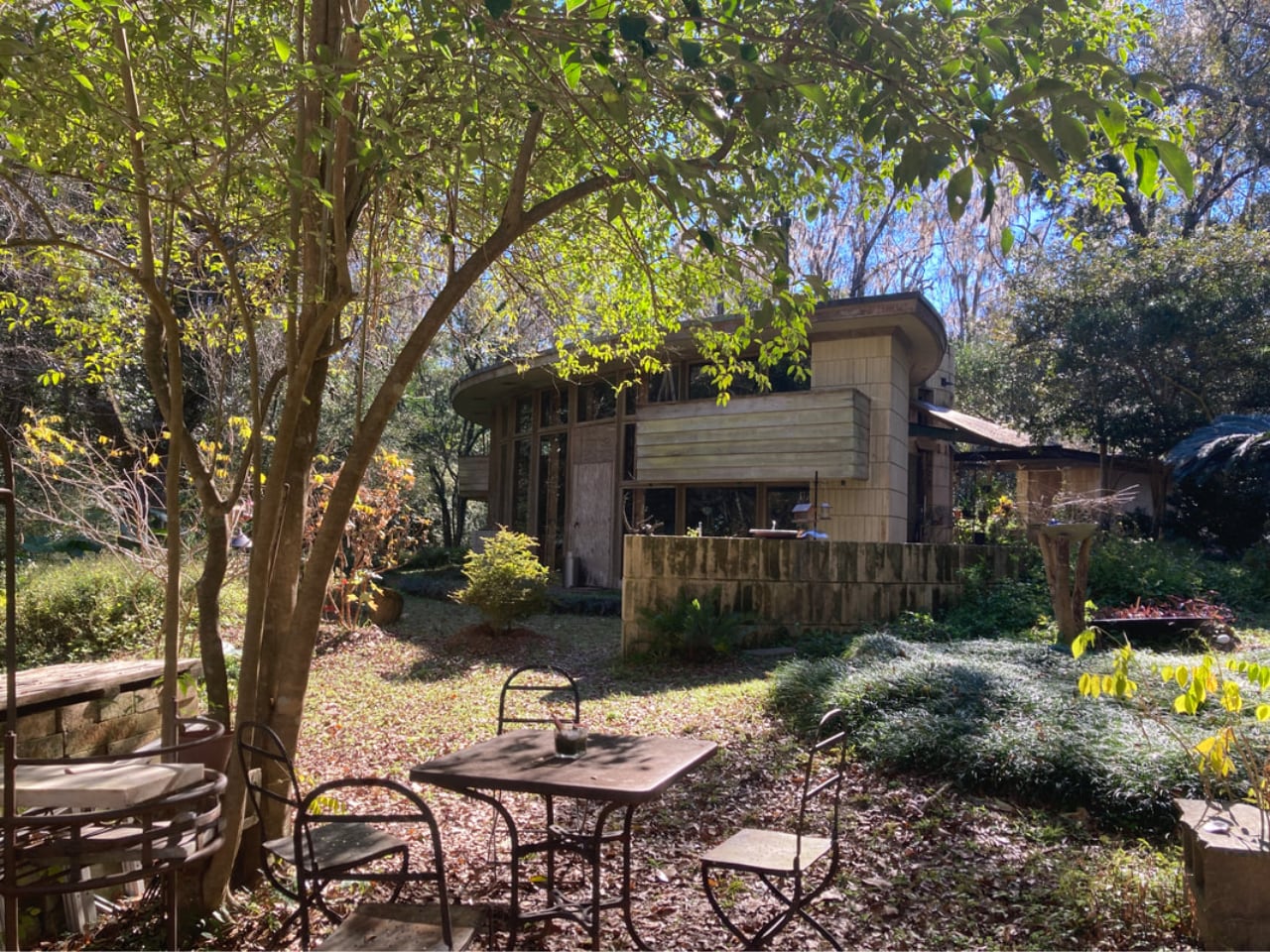Architecture lovers spend decades dreaming of owning a Frank Lloyd Wright home. Most settle for pilgrimage visits. The reality hits hard when they discover that Wright’s surviving homes rarely change hands, and when they do, the price tags often exceed seven figures.
Designer: Frank Lloyd Wright
For those who’ve longed to experience Wright’s organic architecture philosophy firsthand, a unique opportunity has emerged that could change everything. Frank Lloyd Wright’s Spring House for sale represents the only chance to own Wright’s sole Florida residence.
Wright gave the Lewis family what every family deserves: a home that breathes with the land beneath it. Spring House grows from Florida soil like the cypress trees that surround it, not imposed upon nature but born from it. Built in 1954 for Clifton and George Lewis II, this hemicycle house stands as the only private home Wright designed in Florida.
The timing of its creation places it among Wright’s final residential works, completed during the same period as the Guggenheim Museum and sharing similar revolutionary curved geometries. Spring House belongs to an exclusive group of only 11 hemicycle homes Wright ever realized, making it one of the rarest architectural forms in his extensive catalog of over 400 surviving structures. The Lewis family approached Wright in 1950 after meeting him at Florida Southern College, seeking an architect who could create something beyond conventional residential design.
Wright’s response captured his organic philosophy: “find your ground, not on a lot.” The resulting collaboration produced a home that would redefine residential architecture in the American South while establishing Wright’s legacy in a state known more for Spanish Revival and Art Deco influences.
Spring House’s Hemicycle Design: Wright’s Curved Revolution
The hemicycle design represents Wright’s bold departure from his earlier Prairie School rectangles and Usonian L-shapes. Wright created no mere aesthetic choice with this form but organic architecture made manifest.
Sameh Shawky
Where conventional homes fight against their environment with rigid rectangles and harsh angles, Spring House embraces the curves of earth and sky. The architect understood that these concentric circles create spaces that flow like water, allowing families to live together while finding solitude when needed.
Wright positioned the home to embrace its natural surroundings, with floor-to-ceiling windows that dissolve the boundaries between interior and exterior spaces. The resulting design maximizes the connection to nature through strategic window placement that frames the surrounding canopy. At night, reflections in the expansive glass create floating images across the forest, particularly when fires burn in the home’s hearth.
Mashburn, the Lewis daughter who moved to the house at age eight, later recalled the transformative experience of living with the home’s distinctive windows and their relationship to the surrounding forest canopy.
Sameh Shawky
Wright constructed Spring House using Ocala block, a concrete block material popular in mid-century Florida construction that provided both structural integrity and regional authenticity. Tidewater red cypress siding covers both exterior and interior mezzanine surfaces, creating warmth and texture that complements the curved walls. Wright believed in using honest materials to create shelter that serves human life without destroying the natural world that sustains us.
The wedge-shaped carport extends from the home’s west side, completing the sculptural composition that has drawn architecture enthusiasts from around the world for seven decades.
Interior Features of Wright’s Florida Home
Wright understood that every window placement serves a purpose beyond illumination. The hemicycle form delivers practical advantages beyond its striking visual appeal.
Wright oriented the curved walls to capture prevailing breezes while deflecting harsh afternoon sun, creating natural climate control in Florida’s challenging environment. The concentric circles generate intimate spaces within the larger volume, allowing family members to find privacy while maintaining connection to the central living areas. Wright’s spatial organization reflects his deep understanding of how families actually use their homes, prioritizing flow and flexibility over rigid room definitions.
The interior reveals Wright’s mastery of what he called “spatial flow” where rooms dissolve into one another through gentle curves rather than harsh transitions. Built-in seating and storage demonstrate Wright’s belief that furniture should be integral to architecture, not applied afterward. The cypress wood surfaces serve as both finish and structural elements that define the spatial experience. Horizontal emphasis in the ceiling lines draws the eye outward toward the forest views, eliminating the visual barriers that Wright felt trapped people inside conventional rectangular rooms.
Sameh Shawky
Wright designed Spring House to demonstrate his technical innovation through carefully calculated window placement and varied ceiling heights. The curved glass walls follow the sun’s path, ensuring consistent natural illumination throughout the day while preventing glare and heat buildup. Clerestory windows positioned to capture morning light from the east while protecting against harsh afternoon sun create what Wright called “borrowed light” that flows throughout the interior. Morning light awakens families gently through eastern glass while afternoon heat stays outside and breezes flow through carefully planned openings. Evening fires reflect in the glazed walls, bringing forest mysteries into the living space.
Sameh Shawky
Wright’s material honesty appears throughout the interior where Ocala concrete blocks remain exposed, celebrating their structural role rather than hiding behind applied finishes. The tidewater cypress ages naturally, developing patina that Wright saw as architecture living and breathing with time. Mechanical systems disappear into the curved forms rather than fighting against the architectural vision. The mezzanine level creates intimate spaces within the larger volume without sacrificing the sense of openness that defines Wright’s organic approach.
Wright created an environment where occupants feel connected to the changing rhythms of the natural world without sacrificing comfort or functionality. These features remain unrealized, presenting an opportunity for future owners to complete Wright’s original design intent while respecting his organic philosophy.
The integration with the site extends beyond the building envelope through unfinished elements that hint at Wright’s broader vision. Plans included a terrace wall and reflecting pool that would have enhanced the home’s relationship with the natural spring on the property.
Historic Homes for Sale Florida: Market Context
Wright created Spring House as proof that beautiful design need not be expensive ornament applied to cheap construction.
Spring House represents a rare entry point into Wright’s residential portfolio at a time when his works command premium prices nationwide. Listed at **$2,128,000**, the property positions itself competitively within Wright’s market, where recent sales have ranged from $850,000 for the Winn House in Michigan to over $2 million for the Eppstein House, also in Michigan. The Florida location provides year-round accessibility and eliminates the harsh winter conditions that challenge many Wright homes in northern climates.
Sameh Shawky
The ten-acre wooded setting offers privacy and protection that urban Wright properties cannot match. Wright designed the property to face restoration opportunities common to his work from this period. Original tar and gravel roofing systems proved problematic, requiring updates to modern waterproof materials.
The Lewis family maintained the home until 2010, ensuring careful stewardship through its first 56 years. Current condition reports indicate the need for systematic restoration to address deferred maintenance and weathering from Florida’s humid climate. These opportunities present chances for buyers to participate in architectural preservation while creating a personalized living environment.
The home’s inclusion on the National Register of Historic Places in 1979 provides both protection and guidance for future modifications. The designation, granted when the house was only 25 years old, acknowledges its exceptional architectural significance. Tour programs operated by the Spring House Institute have introduced thousands of visitors to Wright’s hemicycle concept, creating a community of supporters committed to the home’s long-term preservation.
Wright Florida Home: Living in Organic Architecture
Wright envisioned daily life in Spring House unfolding according to his philosophy of organic architecture, where buildings grow naturally from their sites and serve human needs without imposing artificial constraints.
Sameh Shawky
The curved walls create unexpected sightlines and intimate conversation areas that encourage family interaction. Open floor plans eliminate barriers between cooking, dining, and relaxing, supporting the informal lifestyle Wright championed throughout his career.
The absence of right angles generates a sense of movement and discovery as occupants navigate spaces that reveal new perspectives with each step. Wright understood that architecture should serve both human spirit and natural world rather than demanding worship of the building itself.
Wright designed the connection to nature to permeate every aspect of the living experience. Evening gatherings center around the hearth, with firelight dancing across the curved cypress surfaces while forest sounds filter through the glazed walls. Seasonal changes become integral to the home’s character as foliage transforms the views and natural light shifts throughout the year.
Wright’s attention to human scale ensures that the dramatic architecture never overwhelms its inhabitants. Ceiling heights vary to create intimacy in private areas and grandeur in public spaces. Built-in furniture and storage solutions maximize efficiency while maintaining clean lines throughout the interior. The hemicycle form generates multiple outdoor living areas sheltered by overhanging roofs, extending usable space beyond the building envelope into the surrounding landscape.
Afternoon breezes flow through strategically placed openings, reducing reliance on mechanical cooling systems.
Architectural Legacy and Future Vision
Wright positioned Spring House to occupy a pivotal position in his architectural evolution, bridging his prairie and Usonian periods with the sculptural freedom that would define his final decade.
Artie White
The hemicycle experiments began with the Unitarian Meeting House in Madison, Wisconsin, and culminated in masterworks like the Guggenheim Museum. Wright created only two pod-shaped residences from this exploration, making Spring House exceptionally rare among his domestic works.
The Florida setting allowed Wright to explore curved forms without the structural constraints imposed by snow loads and freeze-thaw cycles common in his northern projects.
Wright designed the home’s influence to extend beyond its individual architectural merit to represent his broader vision for American domestic life. The Lewis family’s 60-year occupancy demonstrates the design’s success in supporting multi-generational living while adapting to changing needs. Children who grew up in the house remember its initial mystery giving way to deep appreciation for its unique relationship with the natural world.
Sameh Shawky
Adult visitors often report transformative experiences that reshape their understanding of how architecture can enhance daily life.
Wright would have wanted future ownership to present opportunities to complete his original vision while incorporating modern systems and technologies. The unfinished terrace wall and reflecting pool await realization by owners committed to honoring Wright’s intent. Updated mechanical systems can improve energy efficiency without compromising the home’s architectural integrity. Smart home technologies can integrate discretely to enhance comfort and security while preserving the organic aesthetic that defines Wright’s approach to residential design.
For information about tours or purchase inquiries, contact the Spring House Institute. This represents a once-in-a-lifetime opportunity to own Frank Lloyd Wright’s only Florida masterpiece and participate in preserving his organic architecture legacy.
Frequently Asked Questions
How many Frank Lloyd Wright homes are in Florida?
Spring House is Frank Lloyd Wright’s only private residence designed in Florida, making it exceptionally rare among his 400+ surviving structures.
What makes the hemicycle design special?
The hemicycle form uses concentric circles instead of rectangles, creating natural climate control and flowing interior spaces that connect seamlessly with the landscape.
When was Spring House built?
Built in 1954 for Clifton and George Lewis II, Spring House represents one of Wright’s final residential works from the same period as the Guggenheim Museum.
The post Frank Lloyd Wright Spring House for Sale: Only Florida Home first appeared on Yanko Design.

